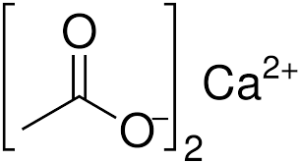Calcium Acetate Formula
Calcium Acetate formula is also known as the Calcium Diacetate formula or Acetate of Lime formula. We shall explain it in this article with structure. This chemical compound is the calcium salt of acetic acid. It consists of four atoms of carbon, six atoms of hydrogen, one atom of calcium and four atoms of oxygen. We shall also explain its chemical formula, structure, and properties here. The student will learn the Calcium Acetate formula with examples here. Let us see the topic!

Source:en.wikipedia.org
Calcium Acetate Formula
What is Calcium Acetate?
It is colorless and white crystalline solid having a slight odor of acetic acid. It can be dissolved in water and alcohol and but it is insoluble in benzene and acetone. In its anhydrous form, it is strongly hygroscopic and therefore occurs as monohydrate in its common form.
This chemical can be obtained by soaking the calcium carbonate or hydrated lime in the vinegar solution. It is widely in use in a variety of food products as a food additive, buffer, sequestrate, and as a stabilizer.
The formula for Calcium Acetate:
Calcium acetate i.e. acetate of lime or calcium ethanoate is a chemical compound widely used in medicine to treat the excess of phosphate in patients suffering from kidney disease.
Its chemical formula is:
Its extended formula is
This salt is formed by two acetate anions
Preparation:
It is prepared by using the minerals as calcium hydrate by the reaction of calcium-containing minerals like calcium carbonate or limestone with acetic acid, which can be a diluted solution. Its chemical equation:
Properties:
Calcium acetate is a white, hygroscopic, acetic acid-like odor solid. Its density is 1.509 g m
It is a chelator, it means this molecule can form a different type of coordinated bond name “chelation”. This is because it has a metallic atom that can bond with other chemical ions.
Calcium atom available in the molecule is very useful to treat the excess of phosphate in the blood. This is because it can react to form calcium phosphate, which is insoluble and can be easily excreted.
Uses:
Calcium acetate is useful for medical treatment to patients with kidney disease. It is also a food additive and largely in use as a chelator. In the past, it was in use as a precursor in the synthesis of acetone.
It is also useful to prevent high blood phosphate levels in patients who are on dialysis. Calcium acetate is a natural mineral that works by holding onto phosphate from the diet so that it can pass out of the human body.
Solved Examples
Q.1: What are some side effects of calcium acetate?
Solution: These are:
- Confusion.
- Nausea
- Vomiting
- Stomach or abdominal pain
- Itching
- Weakness
- Constipation
- Irregular heartbeats
- Increased thirst
Q.2: What is the molar mass of Calcium Acetate?
Solution: Formula is:
Thus its molar mass will be:
=
= 158.17 g per mol.